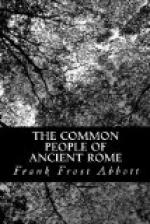sympathy, and help in the emergencies of life, and
the desire to give more meaning to their lives, that
drew them together. These motives explain the
provisions made for social gatherings, and for the
burial of members, which were the characteristic features
of most of the organizations. It is the social
side, for instance, which is indicated on a tombstone,
found in a little town of central Italy. After
giving the name of the deceased, it reads: “He
bequeathed to his guild, the rag-dealers, a thousand
sesterces, from the income of which each year, on
the festival of the Parentalia, not less than twelve
men shall dine at his tomb."[108] Another in northern
Italy reads: “To Publius Etereius Quadratus,
the son of Publius, of the
Tribus Quirina,
Etereia Aristolais, his mother, has set up a statue,
at whose dedication she gave the customary banquet
to the union of rag-dealers, and also a sum of money,
from the income of which annually, from this time
forth, on the birthday of Quadratus, April 9, where
his remains have been laid, they should make a sacrifice,
and should hold the customary banquet in the temple,
and should bring roses in their season and cover and
crown the statue; which thing they have undertaken
to do."[109] The menu of one of these dinners given
in Dacia[110] has come down to us. It includes
lamb and pork, bread, salad, onions, and two kinds
of wine. The cost of the entertainment amounted
to one hundred and sixty-nine
denarii, or about
twenty-seven dollars, a sum which would probably have
a purchasing value to-day of from three to four times
that amount.
The “temple” or chapel referred to in
these inscriptions was usually semicircular, and may
have served as a model for the Christian oratories.
The building usually stood in a little grove, and,
with its accommodations for official meetings and
dinners, served the same purpose as a modern club-house.
Besides the special gatherings for which some deceased
member or some rich patron provided, the guild met
at fixed times during the year to dine or for other
social purposes. The income of the society, which
was made up of the initiation fees and monthly dues
of the members, and of donations, was supplemented
now and then by a system of fines. At least,
in an African inscription we read: “In the
Curia of Jove. Done November 27, in the consulship
of Maternus and Atticus.... If any one shall wish
to be a flamen, he shall give three amphorae of wine,
besides bread and salt and provisions. If any
one shall wish to be a magister, he shall give two
amphorae of wine.... If any one shall have spoken
disrespectfully to a flamen, or laid hands upon him,
he shall pay two denarii.... If any one shall
have gone to fetch wine, and shall have made away with
it, he shall give double the amount."[111]
The provision which burial societies made for their
members is illustrated by the following epitaph:




